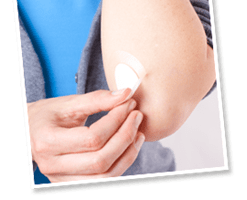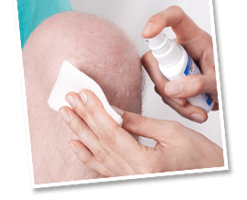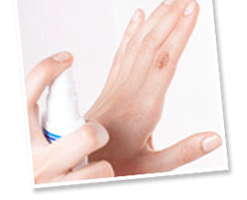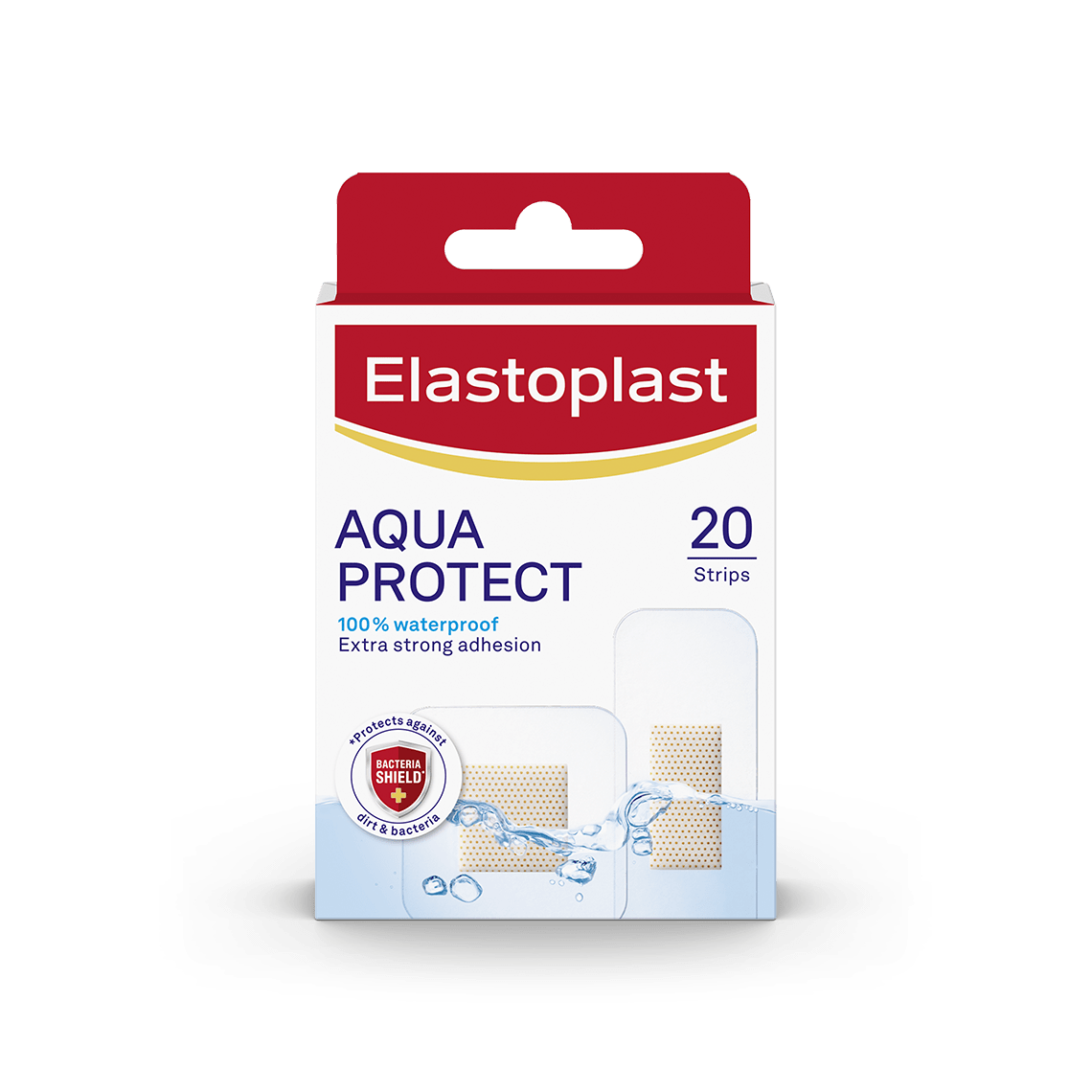01 Myth

This a myth that has persisted for decades. Surprising, as the top priority of wound care should always be to keep a wound as clean, germ-free and protected as possible. That is why after having cleaned the wound with a wound spray (free of alcohol, so that it doesn't hurt) one should always apply a plaster on the injured area!
All Elastoplast plasters are breathable and protect the wound from external influences, so that dirt and bacteria cannot penetrate and the risk of infection is reduced. In addition, the wound pad of the plaster will cushion the wound and protect from painful friction and pressure. Result: wound healing can take place as undisturbed as possible.
02 Myth

Another common myth is that bacteria are supposed to feel especially comfortable under a wound dressing. Quite the contrary is true: Using the correct plaster to cover up a wound which has previously been cleaned out will protect it from contamination through germs and bacteria, thus preventing possible infections. Especially those plasters containing silver as active ingredient of the wound pad are proven to act against a broad spectrum of bacteria and will promote wound healing. The silver contained in their wound pad actually has a direct effect on the bacterias' cell metabolism, preventing a further increase in the number of bacteria and actively combating those microorganisms.
03 Myth

Quite true. For thorough cleaning and taking care of your injury with the right dressing or plaster will help your body heal the best it can. Thus, potential complications such as bacterial infections, re-tearing of the wound caused by external influences and crusty scabs are avoided - all of those being factors that would contribute to scarring.
Plasters such as Elastoplast Fast Healing, based on the principle of moist wound healing are ideally suited to reduce the risk of scarring, leaving your skin with a satisfactory cosmetic result.
04 Myth

Correct. Wounds that take unusually long to heal may very well be a signal of the body. Wounds that are especially reluctant to heal may for example be a typical symptom of a disease such as diabetes mellitus, or may indicate an impaired immune system or blood circulation problems. Therefore it is important to have your wound checked by a doctor for possible causes if you suspect that it takes longer than usual to heal in spite of it being properly cared for.
05 Myth

Thinking that this may be true makes sense somehow, as it is easy to assume that a wound may be the more painful the deeper it is. However, just the opposite can be the case. Due to the large number of nerve fibres located just under the top layer of our skin (the epidermis) superficial abrasions or burns will often cause more pain than a stab or a cut that may happen when working in the kitchen or workshop. Caution: any deep puncture wounds or cuts that bleed severely should always be cared for by a doctor!
06 Myth

Many people tend to apply a plaster in the acute phase of the injury only, that is, just until the bleeding has stopped. Then the plaster is removed and discarded as quickly as possible in order "to let the wound breathe".
Scientific studies have shown, however, that in most cases wound healing will proceed better and without complications if the wound is protected with a plaster until they have healed off completely. There is even a new generation of plasters, such as Elastoplast Fast Healing, which will enable optimal healing conditions for your wound whilst protecting it from harmful external influences.
These special plasters can and should be left on the wound for two days or longer, so as not to interfere with the ongoing healing process and leave the wound intact. If you use a conventional plaster, however, it is recommend to change it every day or to renew it after it has gotten wet, for reasons of hygiene.
07 Myth

Careful! Unfortunately, this is one of the most common misconceptions around. Alcohol is not a good choice for cleaning and disinfecting an injury for a number of reasons: It will not only burn on your skin when being applied which makes it particularly unsuitable for treating children´s wounds. It is also regarded as unsuitable for the sensitive wound tissue. Experts recommend to use products free of alcohol, containing antiseptic agents such as polyhexanide instead, as correct choice for painless wound disinfection and cleaning.
08 Myth

This is a legend that seems to originate from pirate and adventure novels. Even if many of us would love to believe this romantic theory: we are afraid to have to tell you that it is not true.
What many people do not consider is that sea water may be severely contaminated, especially near those coast stretches - with a variety of highly unsavoury germs or chemicals "swimming" in it. Both of which would contribute significantly to the risk of an infection and can delay wound healing. In addition, contact with water will swell the skin, which may affect the process of wound closure. In this case, bacteria and germs may easily enter the wound and the risk of wound infection would be increased even more.
09 Myth

We all know the feeling: some time after an injury, the affected area will begin to tingle and itch. This goes especially for superficial wounds.
And yes – in fact, this itching may indicate that the healing process is well on its way.
But do watch out! Should your wound be very red, suppurate, or the itching turn into a throbbing sensation, you should definitely consult a doctor because these could be signs of an infection that should be treated medically as soon as possible.
10 Myth

Playing down a small wound? Unfortunately, many of us make that mistake. Though it should be clear to anybody that for a bacterium, even the smallest pinprick offers a huge entry hole into our body. Therefore: Always treat any wound with appropriate wound care, no matter how small it may be. This helps to prevent infection and will ensure optimal healing.
Conclusion: Put a plaster on it!
Taking proper care of your injury can accomplish almost small miracles when it comes to your skin; especially if you use the right plaster to cover it. That is why it is worthwhile to always have wound spray and plasters at hand as well as a selection of different plasters and wound dressings in different sizes, so that you are be prepared for all eventualities.
We hope to have clarified a few misconceptions on the topic of wound care and brought you up to date, so that you and your family can benefit from it. Take good care!

Last but not least...
...we would like to point out that all of the above given tips have been compiled carefully, but naturally cannot substitute medical advice and treatment. This applies most notably for larger and large injuries which in any event require medical care. Please always read the instructions for use and/or the patient information leaflet of our products carefully to make the best use of them. Thank you.
Always see your doctor if the wound is deep, bleeding or shows signs of infection like reddening, swelling or warmth.
Also make sure to seek medical help if you are not able to clean the wound properly.
In case you have diabetes a proper wound care is of special importance. Always discuss any concerns you may have with your doctor and/or podiatrist, even for the care of minor wounds and skin cracks – especially on your feet.
Please note that none of the above given tips or recommendations substitute medical advice. Carefully read the instructions for use given in our products‘ packages. Important: consult a health professional in case of any uncertainty of treating your wound properly.
The information provided through this website should not be used to diagnose or treat a health problem or disease. It is not a substitute for professional care or advice. If you have or suspect a health problem, you should consult your doctor. Never disregard professional medical advice or delay in seeking it, because of something you have read on this website.
For further information regarding Elastoplast products, please contact us via email onphc@beiersdorf.com. Carefully read the instructions for use given in our products‘ packages.

